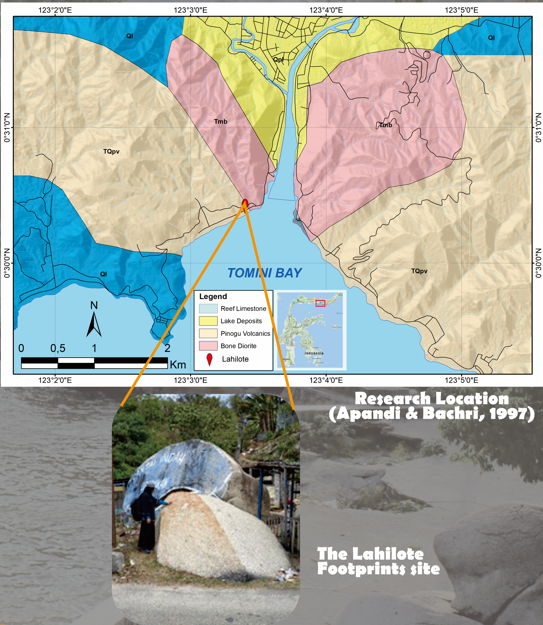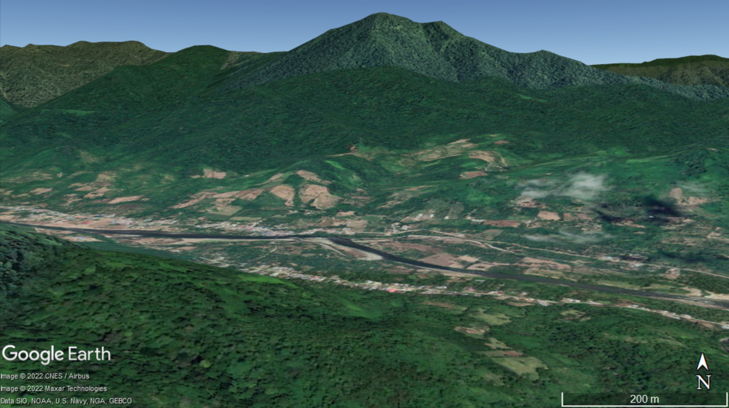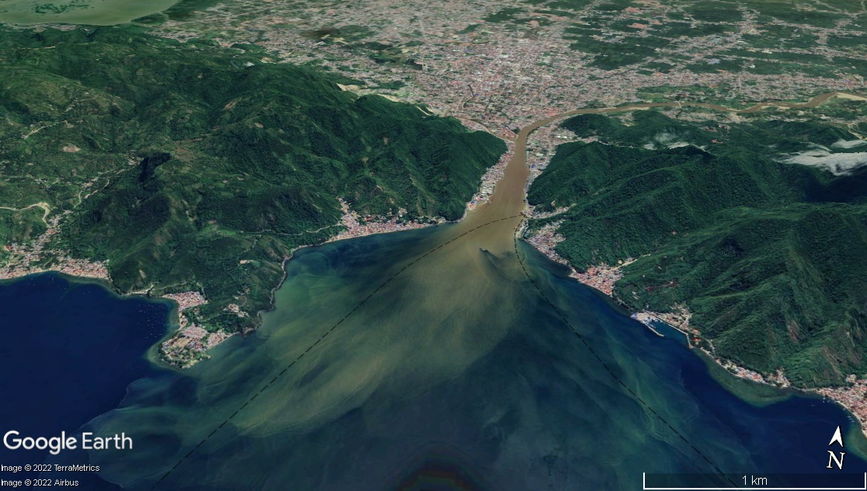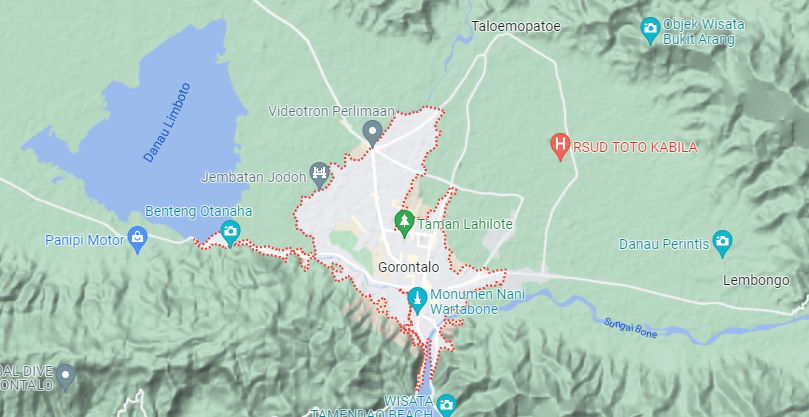Geology of Lahilote Folklore as a Site to Develop Geotourism in Gorontalo

Lahilote footprints in granodiorite rock.
Lahilote folklore is Gorontalo folklore about the footprints of a man named Lahilote. Lahilote footprints are sculpted on rocks located on the southern coast of Gorontalo. Lahilote folklore has been studied by Gorontalo cultural experts, but there is no paper in the field of geology. This study aims to assess the Lahilote footprint site based on its geological characteristics. This research is expected to contribute to the development of geotourism in Gorontalo. The method used is field observation and laboratory analysis. Geosite analysis using the classification of geosite and geomorphosite according to Kubalikova quantification parameters. Field observations include geomorphological and field geological surveys. Rock samples taken from the Lahilote footprint site. Laboratory analysis includes a petrographic analysis and Scanning Electron Microscopy (SEM). The results showed that the Lahilote footprint site was in the intrusion hilly unit. Lahilote footprint sites are formed due to the presence of veins in rocks. The destruction of the side of the rock at the vein boundary leaves the other side of the rock which resembles a footprint. The general description of cite is medium to coarse grained, phaneritic, holocrystalline, hypidiomorphic granular, consists of quartz, alkaline feldspar, plagioclase and mafic minerals. The Lahilote footprint site is granodiorite rock. Based on petrographic analysis, rock-forming minerals are Bt (biotite), Hbl (hornblende), Opq (opaq), Pl (plagioclase), and Qz (quartz). The results of interpretation using SEM show element prediction data contained in rock samples. Lahilote footprint rock sites contain elements of Silicon, Titanium, Allumunium, Ferrum, Manganese, Magnesium, Calcium, Sodium, Potassium, and Cromium. The feasibility values in the geosite and geomorphosite assessments consisting of scientific and intrinsic values (3.5), education values (3), economics values (1), conservation values (2.5, and additional values (2.5) indicate that the geosite Lahilote footprint is feasible to be developed to support geotourism in Gorontalo.
Manyoe, I.N., Masulili, F., & Hutagalung, R. 2020. Geology of Lahilote Folklore as a Site to Develop Geotourism in Gorontalo. The 49th IAGI Annual Convention & Exhibition. IAGI, Lombok.
Sociodemographic attributes and dependency on artisanal and small-scale gold mining: The case of rural Gorontalo, Indonesia

Field location.
The objective of this research is to investigate the livelihoods of villagers of rural Gorontalo, where limited job opportunities and poor infrastructure impede improvements in rural settlements. The research focused on rural regions where small-scale gold mining (ASGM) activities are prevalent in the economy. Given the associated complexities of the livelihoods of the villagers, the paper pays particular attention to household income and its sources and then examines associations with key socioeconomic variables, focusing especially on the contribution of educational development. The questionnaire survey was conducted among households in five villages of rural Gorontalo in August 2017, and 310 effective samples were collected. The results indicate that more affluent households receive a higher proportion of income from formal public sectors, such as government institutions. The source of income from mining accounts for approximately 20%, which is almost constant across the income quartiles. Fractional logit models were employed to examine the dependency of household income on mining. The estimation results indicate that educated households depend less on mining income than do uneducated households. Households with young household heads receive less income from mining than do those with old household heads. The paper implies that low educational attainments are related to a higher dependency on mining, probably due to limited job opportunities in the formal sector. Therefore, improvements in educational attainment are associated with a reduced dependency on the mining sector. The results yield key information for formulating policies for remote villages where a substantial improvement in rural livelihoods is pivotal to reduce dependency in the context of poor ASGM regions.
Komatsu, S., Tanaka, K., Sakakibara, M., Arifin, Y. I., Pateda, S. M., & Manyoe, I. N. (2020, November). Sociodemographic attributes and dependency on artisanal and small-scale gold mining: The case of rural Gorontalo, Indonesia. In IOP Conference Series: Earth and Environmental Science (Vol. 589, No. 1, p. 012020). IOP Publishing.
Sediment material potential of Bone River as a prevention of silting and flood of Bone River estuary, Gorontalo

Bone River estuary. Sediments are transported by river currents towards the estuary and Gorontalo Bay.
Bone River Estuary acts as a connecting lane between the three rivers (Bolango River, Bone River, and Tamalate River) with Tomini Bay. There is a port activity of goods located right on the river estuary, which is potentially disrupted due to the silting and can cause flood. This situation will undoubtedly disrupt port transportation routes and affect the economic condition of Gorontalo. The aim of this research is to identify the potential of sediment utilization at the downstream of the Bone River as an effort to prevent siltation at the estuary of river Bone, Gorontalo and to prevent flood. The method used in this research is field observation which includes observation of the morphological condition of research location and sampling. Samples will then be processed by means of sieving, separation, and classification of Sphericity sediment material by referring to zoning classification and Sneed and Folk classification. The result of histogram data showed that the sediment material was dominated by coarse sand size and grain size distribution dominated by coarse sand with size of phi is 0, on sediment data showed generally very leptokurtic with skewed skill or highly skewed.
Napu, S. S. S., Salama, T. H., Manyoe, I. N., Usman, F. C. A., Samir, I., Badaru, A. W. W., & Sugianti, K. (2020, November). Sediment material potential of Bone River as a prevention of silting and flood of Bone River estuary, Gorontalo. In IOP Conference Series: Earth and Environmental Science (Vol. 589, No. 1, p. 012003). IOP Publishing.
Geology and 2D modelling of magnetic data to evaluate surface and subsurface setting in Bongongoayu geothermal area, Gorontalo

Preparation before data acquisition.
Bongongoayu is one of the regions in Indonesia that has geothermal potential. Bongongoayu requires surface and subsurface data to support the preliminary data. This research aims to determine surface and subsurface data conducted by geology and magnetic method. The surface data, including geomorphology, lithology, hydrology and manifestation. The subsurface data have taken by the magnetic method. The result showed that the geothermal manifestation of Bongongoayu is a hot pool. The surface temperature is 43 to 59 °C. The geomorphology units is composed of volcanic hills unit and lake plains unit. The lithology of the research area is composed of granite and alluvial deposits. Based on petrographic analysis, the level of alteration in granite rocks is 65% and is classified as moderate alteration. The recharge area is in the north and southwest of the research area. Discharge area is in the central area. Based on 2D magnetic modeling, there are two subsurface layers. The first layer is alluvial and the second layer is granite. Rocks that are under the alluvial layer and have been altered are interpreted as a cap rock. 2D magnetic models show normal faults in the research area as a controlling factor for geothermal fluid.
Manyoe, I. N., Suriamihardja, D. A., Irfan, U. R., Eraku, S. S., Napu, S. S. S., & Tolodo, D. D. (2020, November). Geology and 2D modelling of magnetic data to evaluate surface and subsurface setting in Bongongoayu geothermal area, Gorontalo. In IOP Conference Series: Earth and Environmental Science (Vol. 589, No. 1, p. 012002). IOP Publishing.
Chemical content analysis of coral limestone as prospecting of extractive development in Gorontalo City

Research location
The potential of limestone in Gorontalo City is very large and distributed over a wide area. This enormous potential has not yet been exploited. This study aims to determine the chemical content of limestone and the use solution of limestone to improve regional development. Field data collection was carried out in two places, namely Tanjung Keramat and Buli'ide. Sampling was conducted at the coordinates N 0°29'38.93'' and E 123°2'49.62'' for station 1, N 0°32'53.7'' and E 123°1'56.19'' for station 2. The method used in this research is chemical composition analysis using X-Ray Fluorescence (XRF). The results of the analysis of the chemical constituents of Coral Limestone are CaO 83.35%, Fe2O3 6.92%, SrO 9.35% and ZrO2 3.25%. The prospect of Coral Limestone can be used in various industrial fields. Coral Limestone can be used in the mining industry, the cement industry, the sugar industry, ceramic raw materials, building materials, agricultural and road stabilizers. This indicates that the City of Gorontalo has the prospect of development and utilization of limestone resources available, in order to encourage self-reliance and open employment for community.
Annisa, W., Manyoe, I. N., Mubarak, A. K., Napu, S. S. S., Pratama, I. G. S., & Fatimah, S. (2020, November). Chemical content analysis of coral limestone as prospecting of extractive development in Gorontalo City. In IOP Conference Series: Earth and Environmental Science (Vol. 589, No. 1, p. 012021). IOP Publishing.
